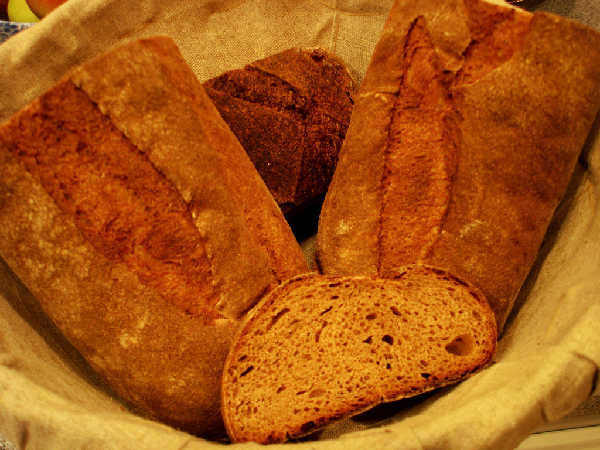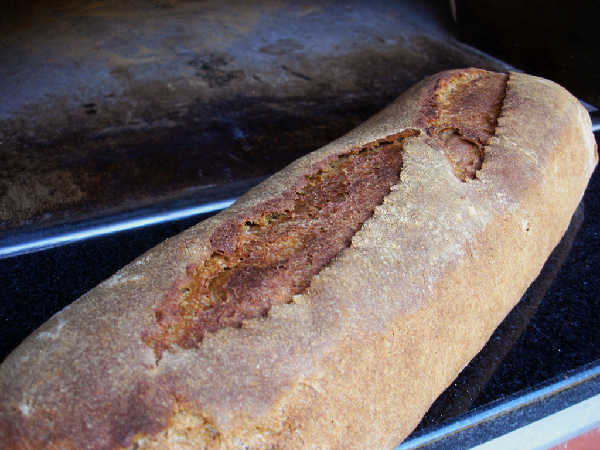

The Whole Wheat Mash Bread, as described in Peter Reinhart's Whole Grain Breads, had a wonderful aroma as it baked. Based on the photos in the book, it came out about as it was intended. The bread was dense and slightly sweet, just as described, and the crumb texture was creamier with the mash.
I included some photos of the bread and a spreadsheet in html and xls formats that breaks out some of the details.
A preferment and a mash are mixed with some additional flour and other ingredients to form the final dough. Instant yeast is used in the final dough to speed up the rise. The idea is that the flavor is already in the preferment and the mash, so the final dough just needs to be raised, which can be done effectively and expediently with instant yeast.
I used a 50/50 mix of Wheat Montana Bronze Chief and Wheat Montana Prairie Gold. The Bronze Chief is a high protein hard red spring wheat. The prairie gold is a high protein hard white spring wheat. I may have needed more water, given my flour choice. Maybe the crumb would have been a little less dense and more tender if hydrated more, which might have suited my bread tastes a little better. However, the results look much like in the photo in Whole Grain Breads and dense was a word used in the description of the crumb in the book.
Mash
- 60 grams (2 oz) Wheat Montana Bronze Chief (use any whole wheat bread flour)
- 60 grams (2 oz) Wheat Montana Prairie Gold (use any whole wheat bread flour)
- 1/2 tsp diastatic malt powder
- 300 grams water
Levain
- 30g (1oz) 90% hydration white flour starter (use any starter, white, whole wheat, rye, etc.)
- 110g (4 oz) Wheat MT Bronze Chief (use any whole wheat bread flour)
- 110g (4 oz) Wheat MT Prairie Gold (use any whole wheat bread flour)
- 150g (5 oz) water
Final Dough
- 122g (4oz) Wheat MT Bronze Chief (use any whole wheat bread flour)
- 122g (4oz) Wheat MT Prairie Gold (use any whole wheat bread flour)
- 15g (0.5 oz, 1 tbsp) malt syrup (or honey, agave nectar, sugar, brown sugar, molasses, or don't use any sweeteners)
- 15g (0.5 oz, 1tbsp) olive oil (or use another fat such as butter, or don't use any fat at all)
- 9g salt (I thought this could have used a touch more salt than was specified)
- 7g (.25 oz, 2.5 tsp) instant yeast
- all of the levain
- all of the mash
Fermentation
The ingredients were mixed directly out of the refrigerator. After mixing, the dough was at about 70F. I let it rise for about 1 hour and 15 minutes to a little more than double, then shaped the loaf into a batard and placed on couche fabric dusted with a mix of rice flour and whole wheat flour. The shaped loaf rose another hour, was placed on a peel and slashed, and finally baked.
Bake
The loaf was baked for 20 minutes in a steamed brick oven preheated to about 450F, then turned off and sealed with towel covered wooden door. The oven door was opened after 20 minutes and the loaf baked in the open cooling oven, dropping from 425F to about 350F (air temperature) for another 30 minutes. The aroma as this bread baked was about as good as I've experienced. I don't know what accounts for the especially good aroma, but the one big difference is the mash.
Results
The bread is a little dense and would be great with any sort of spread. I had put some honey and tahini on it this morning, which was delicious. The flavor is mild, but the sourdough and the mash give it a slightly sweet, slightly sour flavor that is different from other whole grain breads I've made so far. The crumb is creamy and dense at the same time. I would like to try this recipe again but with a little more water, maybe in a pan, and see what happens.
No comments:
Post a Comment
Note: Only a member of this blog may post a comment.